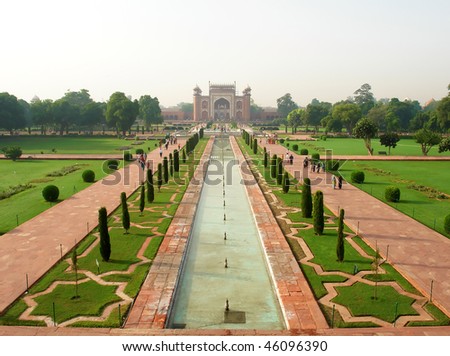
Sir Banister Fletcher put it well in his History of Architecture: 'The Mausoleum of the Taj Mahal at Agra stands in a formally laid-out walled garden entered through a pavilion on the main axis. The tomb, raised on a terrace and first seen reflected in the central canal, is entirely sheathed in marble, but the mosque and counter-mosque on the transverse axis are built in red sandstone. The four minarets, set symmetrically about the tomb, are scaled down to heighten the effect of the dominant, slightly bulbous dome. The mosques, built only to balance the composition are set sufficiently far away to do no more than frame the mausoleum. In essence, the whole riverside platform is a mosque courtyard with a tomb at its centre. The great entrance gate with its domed central chamber, set at the end of the long watercourse, would in any other setting be monumental in its own right.' It is the most perfect chahar bagh plan in existence. Edward Lear wrote: This perfect and most lovely building infinitely surpassed all I had expected, principally on account of its size, and its colour. It is quite impossible to imagine a more beautiful or wonderful sightナ What a garden!... the great centre of the picture being ever the vast glittering ivory-white Taj Mahal, and the accompaniment and contrast of the dark green of the cypresses, with the rich yellow green trees of all sorts! And then the effect of the innumerable flights of bright green parrots flitting across like live emeralds I sometimes think that never blows so red The Rose where some buried Caesar bled; That every Hyacinth the Garden wears, Dropt in her Lap from some once lovely Head. RUB-IY-T OF OMAR KHAYYAM THE 'Paradise-like Orchard' of the Lady Arjumand Banu, Begam, is more familiar to us as the garden-tomb of Mumtaz Mahal-the Crown of the Palace and Lady of the Taj. So much has been written in praise of this famous building, and photographs and pictures have made it so familiar, that it might seem needless to add any impressions of my own, were it not that most writers are too enchanted with the beauty of the actual tomb to realise the close connection of the whole group of buildings, and that the garden as originally planned formed an integral part of one great design.
Style: Persian
Divided Into: Four Parts
Canals: Two (crossing in the centre)
Flowerbeds: Sixteen
Trees: Cyprus & Fruit Bearing
The garden that starts from the end of the main gateway and ends near the squared base of the mausoleum is an integral part of the Taj Mahal structure and is, undeniably, one of the major highlights of the visit for many. The garden that beautifies Taj comes from the Persian Timurid style of gardens, and is based on the concept of ‘paradise garden' and was brought in by Babur. This garden, filled with flowers, fruits, birds, leaves, symmetry, and delicacy, served many functions along with portraying strong symbolic or abstract meanings about paradise. A paradise which, according to Islamic beliefs,consists of four rivers: one of water, one of milk, one of honey, and one of wine. And it is from this concept that Char Bagh of Taj Mahal originated. Also, the symbolism of the garden and its division are noted in the Islamic texts that describe paradise as a garden filled with abundant trees, flowers, and plants.Out of the total area of 580 meter by 300 meter of the Taj complex, these gardens alone cover an area of 300 meter by 300 meter distance and are
based on geometric arrangements of nature. No attempt was made to give them a "natural" look. Another architectural attribute that has been followed in the case of the entire monument, especially the gardens of the Taj Mahal of Agra, is the usage of number four and its multiples. Since four is considered the holiest number in Islam, all the arrangements of Charbagh Garden of Taj Mahal are based on four or its multiples. The entire garden is divided into four parts, with two marble canals studded with fountains crossing in the center. In each quarter portion, there are 16 flowerbeds that have been divided by stone-paved raised pathways. It is said that even each of the flowerbed was planted with 400 plants. The trees of the Taj garden are either that of Cyprus





No comments:
Post a Comment